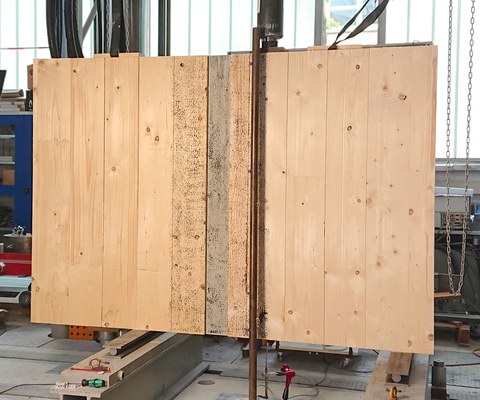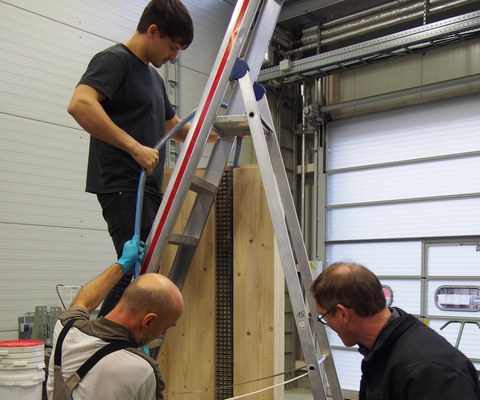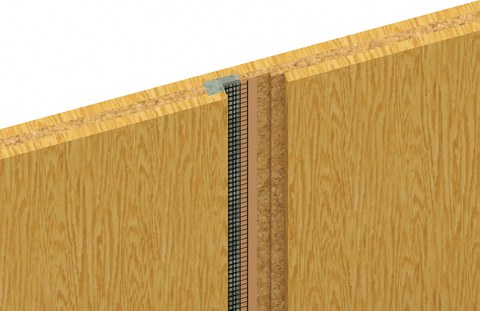CRC joints for cross laminated timber wall constructions
Table of contents
Project data
| Titel | Title Entwicklung einer Verbindungsmitteltechnologie für Brettsperrholz-Wandkonstruktionen mit hohem Schubwiderstand | Development of a joint technology for cross laminated timber wall constructions with high shear resistance Förderer | Funding Bundesinstitut für Bau-, Stadt- und Raumforschung (BBSR) / Forschungsinitiative ZukunftBAU Zeitraum | Period 12/2018 – 06/2021 Projektleiter | Project manager Prof. Dr.-Ing. Dr.-Ing. E.h. Manfred Curbach Bearbeiterin | Contributor Dipl.-Ing. Kristina Farwig Projektpartner | Project partners Auerbach und Hahn GmbH, Wilsdruff | AIB GmbH, Bautzen |
Report in the annual report 2021
Let hybrid buildings grow

Testing of a large component without wooden flanks with a CRC connection
In order to reduce the amount of building materials used in building construction, more sustainable high-rise buildings can be constructed as hybrid construction of cross-laminated timber (CLT) and concrete as an alternative to completely reinforced concrete structures. But to be able to build high with prefabricated CLT panels, the shear load-bearing capacity of the butt joints between the elements must be guaranteed. For this reason, a connection technology was developed in the research project “CLT Connectors”. The aim was to connect the prefabricated CLT wall panels to a groove made of grouted concrete.
For the transmission of shear force between wood and concrete, additional fasteners were inserted into the CLT narrow side. Therefore screws, a perforated steel plate, notches or textile grids glued in timber at 45° were used and experimentally investigated.
To determine the load-bearing capacity of the different connecting systems compression-shear tests on 60 cm high test specimens as well as additional bending shear tests on joined 1.50 m high wall-like beams were carried out. Different failure mechanisms occurred in the respective tests. The screws could withstand the shear stresses up to pull-out or shear failure according to their insertion in the wood. The carbon grids glued into the wood were pulled out of the concrete in the direction of the shear force as the anchorage length was not sufficient and sheared off against the direction of the shear force. In contrast, the connection via a perforated steel plate in the CLT middle layer led to transverse compression failure of the timber.
Using stiffer notches, the connection between CLT and concrete failed brittly in the concrete in the area of the notch and in the timber in the area of the fasteners. Compared to the compression shear tests, it could be shown in the bending shear tests that the stiffness and load-bearing capacity of the investigated CLT wall joint increased in the case of concrete connection compared to a conventional butt deck strip. Therefore a shear-resistant connection between the wall elements was achieved.
Report in the annual report 2020
Filigree shear connections for precast wood elements made of carbon reinforced concrete

Production technology with internal concrete groove for connecting two cross laminated timber wall elements (for observation through Plexiglas pane)
Innovative composite building materials such as carbon concrete are nowadays enabling increasingly slender and thus material-efficient structures. These are in demand for both aesthetic and ecological reasons not only in new construction but also in building renovation. Accordingly, a high level of manufacturing effort is required. As an alternative to prefabricated carbon concrete elements, slender flat components can be produced as prefabricated elements for building construction using new types of wood-based materials such as cross-laminated timber in a way that is efficient in terms of both production and materials.
However, the connecting joint of the precast elements is usually a weak point in terms of the load-bearing capacity under high stress conditions and can only be generated on the construction site using a large number of externally visible metallic fasteners. In the case of cross-laminated timber wall constructions, the internal connections desired by architects and users can be realized using tongue-and-groove systems, which have to be installed over the entire height of the wall. Expensive dovetail elements made of wood do not guarantee sufficient load-bearing capacity under high load conditions.
In order to extend the range of application to building class 4 and to generate a higher shear resistance between the wall elements, while at the same time enabling a high degree of prefabrication of the building elements in the factory and rapid assembly on-site, a connection technology is being developed in this research project in which wall structures made of cross laminated timber are connected in a shear-resistant manner via a concrete groove with additional internal connecting means. Based on the classic wood-concrete composite construction method, tried-and-tested steel fasteners (composite screws and perforated plates) are inserted into the wood groove in the factory and filled with grout using a concrete pump. Furthermore, textile scrims are glued into the BSPH at an angle of 45° and grouted with concrete in the groove. These are to absorb the tensile stresses in the concrete generated by shear forces in the joint. The shear capacity of the connection is tested in compressive shear tests on 60 cm high specimens. From the tested joints, a high-performance and at the same time construction-practical variant will be selected to be tested in trials on large components and thus serve as a demonstrator for the novel joint technology.
Report in the annual report 2019
JOINING OF WOODEN CONSTRUCTIONS WITH CARBON REINFORCED CONCRETE

Connecting cross laminated timber walls with carbon reinforced concrete
Global discussions about climate change also call for a rethink in the construction industry, which goes hand in hand with more resource-efficient construction methods. Therefore, to reduce CO2 emissions, research that focuses on alternative construction methods that can compete with conventional reinforced concrete construction on the market is being conducted. In addition to the development of new, high-performance building materials, the combination of different materials also plays a major role. The wood-concrete-composite construction method is one way of using the existing materials within the cross section of the component according to their efficiency. It is not only used for the renovation of ceiling structures but also in new buildings.
In the course of the construction of buildings consisting of several material components, the efficiency at the construction site plays an important role. This can be increased by a high degree of prefabrication. Individual components only have to be assembled on site. For example, in residential buildings, up to building class 3, the prefabricated construction method with cross-laminated timber, comprising wall or ceiling elements which are transported to the construction site, enables economical and sustainable construction with the natural raw material wood, and it also meets the aesthetic requirements of planning architects and the users of the buildings.

Shear test on the wood-concrete composite specimen in the Otto Mohr Laboratory as part of the diploma thesis of Franziska Rößger
However, one disadvantage of prefabricated construction with wood and wood-based materials, is that the elements are assembled on site. This is partly complex and requires a high number of metallic fasteners. Alternatively, the components can be connected on-site by filling the joint in the connection of the precast wall with concrete. The joining of the walls or wall-ceiling connections can be carried out at all angles with concrete in the form of a tongue-and-groove connection. This connection system will be investigated analytically and experimentally in different variants. Due to the limited space available for the connection, the use of glued-in textile reinforcement to absorb tensile stresses due to shear stress is considered. This results in a connection system with high shear resistance, which could also be used in the future in more extreme applications, such as high-rise or multi-storey parking garages.
